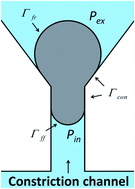Measuring the apparent viscosities of single cells by tracking the entire deformation dynamics in microfluidic channels
Abstract
Cellular mechanical properties are promising biomarkers to indicate the disease states of patients. Two methods, i.e., transient method and time-averaging method, for calculating cellular viscosity in micropipette aspiration studies have been formulated for a microfluidic device. Compared to similar methods in the literature, the time-averaging method has been modified to cope with the more realistic situation that the apparent viscosity is time-varying rather than a constant. To implement the methods, a microfluidic device with high efficiency of trapping single cells has been designed and used to measure the apparent viscosities of single cells. By analyzing the experimental results, the two methods have been compared carefully. The modified time-averaging method yielded more steady calculation results and more comprehensive information about cellular apparent viscosity by taking into account the whole cellular deformation dynamics process. Based on this method, apparent viscosities of single cancer cells (HeLa cells) and human umbilical vein endothelial cells (HUVECs) have been measured. It is concluded that the microfluidic device coupled with the time-averaging method can effectively quantify the viscosities of single cells.



 Please wait while we load your content...
Please wait while we load your content...